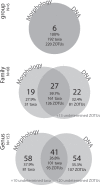Human access impacts biodiversity of microscopic animals in sandy beaches
- PMID: 32313088
- PMCID: PMC7170908
- DOI: 10.1038/s42003-020-0912-6
Human access impacts biodiversity of microscopic animals in sandy beaches
Abstract
Whereas most work to understand impacts of humans on biodiversity on coastal areas has focused on large, conspicuous organisms, we highlight effects of tourist access on the diversity of microscopic marine animals (meiofauna). We used a DNA metabarcoding approach with an iterative and phylogeny-based approach for the taxonomic assignment of meiofauna and relate diversity patterns to the numbers of tourists accessing sandy beaches on an otherwise un-impacted island National Park. Tourist frequentation, independently of differences in sediment granulometry, beach length, and other potential confounding factors, affected meiofaunal diversity in the shallow "swash" zone right at the mean water mark; the impacts declined with water depth (up to 2 m). The indicated negative effect on meiofauna may have a consequence on all the biota including the higher trophic levels. Thus, we claim that it is important to consider restricting access to beaches in touristic areas, in order to preserve biodiversity.
Conflict of interest statement
The authors declare no competing interests.
Figures



References
-
- Cheong S-M, et al. Coastal adaptation with ecological engineering. Nat. Clim. Change. 2013;3:787. doi: 10.1038/nclimate1854. - DOI
-
- Agardy, T. S. Marine Protected Areas and Ocean Conservation (Academic Press, 1997).
-
- Badalamenti F, et al. Cultural and socio-economic impacts of Mediterranean marine protected areas. Environ. Conserv. 2000;27:110–125. doi: 10.1017/S0376892900000163. - DOI
-
- Defeo O, et al. Threats to sandy beach ecosystems: a review. Estuar. Coast. Shelf Sci. 2009;81:1–12. doi: 10.1016/j.ecss.2008.09.022. - DOI
Publication types
MeSH terms
Substances
LinkOut - more resources
Full Text Sources

